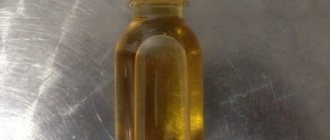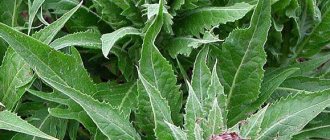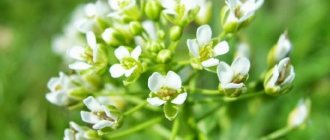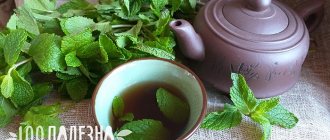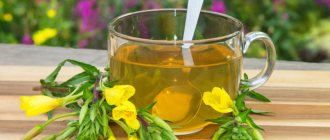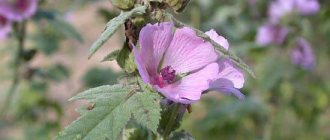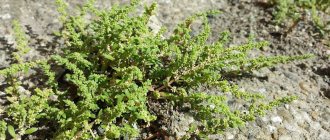| Meadowsweet | |
| Scientific classification | |
| intermediate ranks |
| Kingdom: | Plants |
| Sub-kingdom: | Green plants |
| Department: | Flowering |
| Class: | Dicotyledons[1] |
| Superorder: | Rosanae |
| Order: | Rosaceae |
| Family: | Pink |
| Subfamily: | Rosanovye |
| Tribe: | Ulmarieae Lam. & DC., 1806 |
| Genus: | Spiraea |
| View: | Meadowsweet |
() Maxim., 1879 Synonyms
- Spiraea ulmaria L.basionym
- Ulmaria pentapetala Gilib.[2]
- Ulmaria palustris Moench[3]
and many others[4]
| NCBI | 57917 |
| EOL | 629935 |
| GRIN | t:17105 |
| IPNI | 724943-1 |
| TPL | rjp-1024 |
Meadowsweet
, or
Meadowsweet
, or
Meadowsweet
(lat. Filipéndula ulmária) is a perennial herbaceous plant of the Rosaceae family
,
growing in wet meadows in Europe and Western Asia, and also introduced and naturalized in North America.
Biological description
Botanical illustration by Jacob Sturm from the book Deutschlands Flora in Abbildungen
, 1796
A perennial herbaceous plant up to 1.5–2 m high with an erect, smooth, ribbed, densely leafy, simple or branched stem and a fibrous root system. Creeping rhizome[6]. Roots without tuberous thickenings[7].
The leaves are intermittently pinnately divided with two to three pairs of lateral pointed serrates and one larger terminal leaflet, divided into 3-5 lobes. They are bare dark green above, white felt below. Between the large leaves there are intermediate small, sharply toothed leaves. When rubbed, the leaves emit a pungent odor[6]. The lateral leaflets of the basal leaves number four to ten pairs, from broadly ovate to ovate-lanceolate, entire or slightly lobed, incised serrate[7].
The flowers are numerous small yellow-white cream fragrant, collected in dense loose panicles up to 20 cm long. There are five petals and calyx lobes[7] (rarely six petals[6]). Petals with a long nail; hypanthium flat; stamens are 1.5-2 times longer than petals[6]. Blooms in June-July.
The fruit is a multi-leaflet, consisting of 10-15 spirally twisted, bare, single-seeded leaflets that harden as they ripen. Fruiting in July-August. One plant produces up to five hundred seeds. Seeds are dispersed by wind or water[6].
The number of chromosomes is 2n = 14 (16)[3].
Application of whitehead
The plant is often used in the manufacture of not only decoctions, tinctures and medicinal preparations, but also in the manufacture of ointments that are used for rheumatism, psoriasis and other skin diseases accompanied by severe itching and redness.
- Ointment recipe. Whitecap tubers are dried and then ground to a powder. The finished raw materials can be ground with butter, or you can use olive or coconut oil at the rate of one part powder to 5 parts fat.
- Meadowsweet tea. A tablespoon of herb is poured into 300 ml. boiling water, let it brew for 15 minutes, filter. Tea can be taken twice a day, especially effective for colds accompanied by high fever, and before bed for insomnia.
- Infusion of whitecap stems. Pour 2 teaspoons of whitehead into 250 ml. water at room temperature and leave in a jar with a lid for about 8-10 hours, then filter. If the solution will be stored for a long time, you can add a little chamomile herb. Apply 50 ml twice a day. In addition to oral use, this infusion can be used in the treatment of inflammatory diseases of the epidermis: furunculosis and skin ulcers.
- Infusion of whitecap flowers. Add 3-4 tsp to half a liter of boiling water. flowers, infuse for about 4-5 hours. It is better to brew in a thermos, since with such gentle action the maximum amount of beneficial substances is released.
- Preparation of flower powder. Dried flowers can be crushed into powder, which is used in the treatment of shallow burns, to prevent bedsores and diaper rash.
- Alcohol tincture. 2 tsp. whitehead herbs are poured with 70% alcohol and placed in a dark place in a glass jar with a tightly closed lid for 10 days. Take 5-10 drops daily. The dose should be increased gradually.
Like any medicine, whitecap herb has not only medicinal properties, but also contraindications.
Distribution and ecology
Meadowsweet is common in Europe (Scandinavia, Central Europe, countries on the Atlantic coast, the central regions of Ukraine - rarely, the Carpathians - rarely, the Northern Black Sea region) and in many areas of Asia (Central Asia - the northern part, in the mountains up to the Dzungarian Alatau; Asia Minor , Mongolia)[3].
In Russia, it is found in the European part (except for the extreme southeast; rarely in the Upper Volga region), in the Ciscaucasia, Western and Eastern Siberia (only in the southern part of Transbaikalia to the Khentei Plateau)[3][6].
It grows in damp lowland and post-forest meadows and lowland grassy swamps, on the edges of swampy forests, in floodplain and damp shady forests, along the banks of reservoirs and ditches[3][6].
Plant composition
Whitecap, whose medicinal properties extend to all parts of the plant, can be broken down into a number of components. Most of them are very useful for sick and healthy people.
Medicinal properties of whitecap
| Substance | Benefits for the body |
| Acetylsalicylic acid (aspirin) | anti-inflammatory, antipyretic, analgesic effect |
| Ascorbic acid | accelerating the growth and restoration of hard and soft tissue cells, increasing iron absorption, launching immune mechanisms, protecting against infections |
| Phenolic, tannin compounds | anti-inflammatory, antimicrobial, astringent, bile- and diuretic, hypotensive effect |
| Coumarins | antispasmodic, anticoagulant, antitumor effect |
| Phenolcarboxylic acids (ellagic, caffeic) | neutralization of inflammatory, hypertensive, oxidative, HIV processes; cardioprotective, antimutagenic, hemostatic, antitumor properties |
| Catechins | antioxidant effect at the cellular level |
| Steroids | adaptation to physical and nervous stress, stimulation of vascular and cardiac activity, regulation of blood sugar |
| Minerals | balance of metabolic reactions |
| Essential oil | restoration of cartilage and articular joints, breakdown of fat, removal of edema, stabilization of the nervous system and hormonal levels |
| Flavonoids (pigments) | maintaining youth and health |
There are no poisons in the whitecap, and the interrelation of many components is successfully balanced by natural buffer compounds. Thanks to this, there are practically no side reactions.
Economic importance and application
Meadowsweet is rich in tannins and is suitable for dyeing and tanning light and heavy leathers, but is not used by the tanning industry[8].
A good honey plant[8].
Young shoots are used as salad in the Caucasus[8].
The plant has long been used in folk medicine. All parts of the plant are used for medicinal purposes - grass, flowers and roots. Meadowsweet is included in the official pharmacopoeia of many Western European countries, but its use is especially widespread in folk medicine. An infusion of the herb is used for colds and rheumatic pain. A decoction of the roots is used as a tonic and diuretic. A decoction of flowers is valued as a proven remedy for dropsy, rheumatism and gout. Compresses with an infusion of herbs or roots are applied to joints affected by arthritis or rheumatism, and are also used to wash the eyes for conjunctivitis. The herb tincture has an antibacterial effect and promotes epithelization of trophic ulcers on the legs, wounds and burns and can be used as a wound healing agent. In the same cases, ointment is successfully used. Powder from dried flowers was previously sniffed for a runny nose[8].
In the experiment, a decoction of flowers has vascular-strengthening, anti-inflammatory, antiulcer, and stress-protective properties [9].
Flowers and leaves sometimes serve as a tea substitute[8].
| From left to right: Thickets of meadowsweet, basal leaves, stem leaves, inflorescence, flower, fruits |
Medicinal properties
Whitehead products have nootropic, immunostimulating, and adaptogenic effects . The whole plant is used to prepare the medicine. The root removes helminths and calms the nervous system. The grass is sprinkled on diaper rash, eczema, and wounds. Flowers are used for diarrhea, heart disease, and seizures. Meadowsweet oil is considered a universal pharmacological form that has the properties of decoctions, tinctures and ointments. Due to its medicinal properties, whitecap:
- relieves pain;
- effectively fights bacteria;
- used for allergic reactions;
- used for inflammatory diseases;
- is a diuretic;
- normalizes appetite;
- increases immunity;
- helps in the treatment of joints;
- normalizes hormonal levels;
- brings down the high temperature.
What diseases does it help with?
Whitehead-based products are used everywhere; herbalists recommend using it regularly as a general tonic and to restore strength. The meadowsweet plant is called a cure for forty ailments, since it is used for the following diseases and conditions:
- rheumatism;
- thrombosis, thrombophlebitis and strokes;
- diabetes;
- phlebeurysm;
- colds and viral diseases;
- herpes;
- gum disease;
- cardiovascular pathologies;
- hypertension;
- ulcers and gastritis;
- a number of gynecological diseases;
- haemorrhoids;
- migraine;
- skin diseases;
- memory disorders;
- insomnia;
- diaper rash, bedsores;
- sore joints;
- shallow burns;
- furunculosis.
Article on the topic: Binswanger's disease - causes, symptoms, diagnosis, treatment and prognosis
Notes
- For the convention of indicating the class of dicotyledons as a superior taxon for the group of plants described in this article, see the section “APG Systems” of the article “Dicotyledons”.
- Plants For A Future - Filipendula ulmaria (English) (Retrieved July 24, 2009)
- ↑ 12345
Tsvelev, 2001. - See TPL link in plant card.
- Dahl, 1880-1882.
- ↑ 1234567
Gubanov et al., 2003, p. 368. - ↑ 123
Gubanov et al., 2003, p. 336. - ↑ 123456
Gubanov, 1976. - ↑ 12
Blinova, 1990.
Traditional recipes - how to cook
Both fresh and dried raw materials are used to prepare potions. Decoctions and infusions can be given even to children, but subject to strict adherence to dosages and the consent of the attending physician. The medicines have a pleasant taste, which is very important when treating children, and quickly bring down high fevers
Alcohol tinctures are for adults only! They can be used both internally (a few drops at a time) and externally for rubbing.
Ointments are prepared to combat skin diseases.
Whitehead ointment and oil
To prepare the ointment, you need to grind 20 grams of dry grass and mix with lanolin or petroleum jelly. Use immediately after preparation.
Meadowsweet oil is also useful, it helps in the fight against:
- tumors;
- warts;
- mastopathy;
- bronchitis and sinusitis.
It is quite difficult to prepare oil at home, but you can make something similar to this:
- 2 tablespoons of dried flowers;
- 1 glass of vegetable oil (preferably olive).
Place crushed dried flowers into a glass jar and add oil. Let it brew for 14 days.
Whitehead tea
The body needs immune support in autumn and spring. Meadowsweet tea is suitable for this. It will help compensate for the lack of vitamin C and avoid colds.
To prepare tea you will need:
- 500 milliliters of boiling water;
- 1.5 teaspoons of dried plant.
Pour the grass into a thermos and add boiling water. Let sit for at least 2 hours. Then strain through a sieve and add a few tablespoons of honey.
You can make tea from whitehead, chamomile, rosehip and lemon balm.
Alcohol tincture
To prepare you will need:
- 500 milliliters of alcohol;
- 50 grams of meadowsweet.
Place chopped herbs in a jar and fill with alcohol. Close with a tight lid and place in a cool, dark place. Leave for 14 days.
The tincture is used both internally and externally. For the prevention and treatment of colds and inflammatory processes. Also rubbed into joints for arthrosis and arthritis. It is also used to reduce muscle pain.
We advise you to read: What are the benefits of pumpkin seeds?
Decoction
Meadowsweet makes the skin smooth, helps get rid of acne and enlarged pores.
Recipe for whitehead decoction:
- 1 glass of water;
- a tablespoon of finely chopped herb roots.
Pour water over the roots and simmer over low heat for 5-7 minutes.
You can also make a decoction in a water bath. Cooking time 15-20 minutes. Then let it brew for an hour and strain.
Take a tablespoon 3-4 times a day.
The decoction is taken orally for the following diseases:
- gynecological;
- oncological;
- intestinal disorder;
- liver diseases;
- epilepsy;
- rheumatism;
- gout.
Infusion
To prepare you need:
- 1 teaspoon of dry chopped shoots;
- 200 milliliters of boiling water.
Pour boiling water over the crushed meadowsweet and let it brew for an hour. Strain before use. The portion is designed for one day, for 4-5 doses.
Another infusion option:
- 1 teaspoon roots;
- 250 milliliters of water.
Pour water over the crushed roots and let it brew for 8-10 hours. Take 3-4 times a day.
Infusions are useful for:
- erosions and ulcers;
- trophic ulcers and non-healing wounds;
- as a sedative;
- female diseases: inflammation, thrush, endometriosis;
- problems with the thyroid gland.
Literature
| Wikisource has texts on the topic: “ Meadowsweet ” |
- Spiraea Ulmaria // Botanical Dictionary / comp. N. I. Annenkov. - SPb.: Type. Imp. AN, 1878. - XXI + 645 p.
- Bater // Explanatory dictionary of the living Great Russian language: in 4 volumes / author's compilation. V. I. Dal. — 2nd ed. - St. Petersburg. : Printing house of M. O. Wolf, 1880-1882.
- Meadowsweet // Encyclopedic Dictionary of Brockhaus and Efron: in 86 volumes (82 volumes and 4 additional). - St. Petersburg, 1890-1907.
- Gubanov I. A. et al.
732.
Filipendula ulmaria
(L.) Maxim.
sl [incl. F. denudata
(J. et C.Presl) Fritsch,
F. stepposa
Juz.] - Meadowsweet, or Meadowsweet, silt Meadowsweet // Illustrated guide to plants of Central Russia. In 3 volumes - M.: Scientific T. ed. KMK, Institute of Technology. research, 2003. - T. 2. Angiosperms (dicotyledonous: separate-petalled). - P. 368. - ISBN 9-87317-128-9. - Kamelin R.V.
Meadowsweet, Meadowsweet // Flora of Eastern Europe / Rep. ed. and ed. volumes N. N. Tsvelev. - St. Petersburg: Peace and Family; Publishing house SPHFA, 2001. - T. X. - 670 p. — 700 copies. — ISBN 5-8085-0122-9. - Gubanov I. A. et al.
Wild useful plants of the USSR / resp. ed. T. A. Rabotnov. - M.: Mysl, 1976. - P. 175-176. — 360 s. — (Reference books for geographers and travelers). - All about medicinal plants in your garden beds / Ed. Radelova S. Yu.. - St. Petersburg: LLC "SZKEO", 2010. - P. 217. - 224 p. — ISBN 978-5-9603-0124-4.
- Blinova K.F. et al.
Botanical-pharmacognostic dictionary: Reference. allowance / Ed. K. F. Blinova, G. P. Yakovleva. - M.: Higher. school, 1990. - P. 202. - ISBN 5-06-000085-0.
Damage to whitehead
Meadowsweet is not able to reduce appetite, increased due to a diet unbalanced in proteins, fats and carbohydrates. The tincture has no effect on the psychological causes of overeating. The inability to deal with stress and switch your consciousness to what a person is doing at the moment cannot be “treated” with herbal tinctures. In the presence of the above problems, drinking herbal infusions only creates an imitation of vigorous weight loss activity and a negative psychological mood. It seems to a person that he has already tried everything possible, and since such strong remedies as whitecap decoction do not help, he should return to his previous way of life with a clear conscience.
Self-treatment of such serious diseases as diabetes and hypertension is not acceptable. A person cannot always identify the true cause of symptoms. The same thirst and periodic weakness may have nothing to do with diabetes, but be a sign of an unbalanced diet, stress and dehydration. Pressure surges may not be an independent disease, but a manifestation of VSD. Therefore, before taking herbal infusions, you should consult a doctor.
Only a professional physician can draw a conclusion about the compatibility of whitehead with other drugs and medicinal plants, therefore, when self-medicating, if you still choose this option, it is not recommended to “strengthen” the diuretic and sedative properties of herbs with other herbs and drugs.
Read useful information about other medicinal plants:
Monarda Melissa Aloe Oregano Rosemary Elecampane Thyme Coltsfoot



